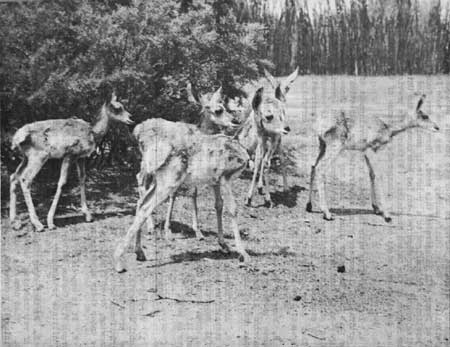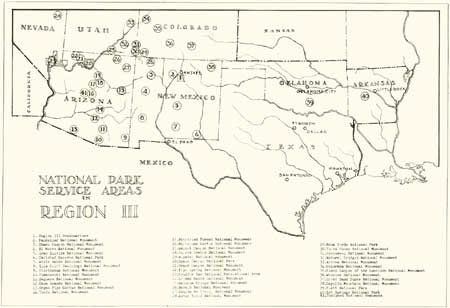|
WILDLIFE MANAGEMENT
By Dr. W. B. McDougall,
Regional Wildlife Technician.
The chief ultimate goal of the Wildlife Division of
the National Park Service in Region III is the restoration,
preservation, and presentation to the public of complete biotic
communities in all park areas in the Region. In order that this may be
accomplished intelligently and successfully, it is necessary that there
be an intimate knowledge of all species of plants and animals now
existing in the park areas, their abundance and distribution, and their
gross ocological relations.
It also is necessary that it be known, sa far as
possible, what species formerly existing in the areas are now absent,
the reasons for their disappearance, and what factors are favorable or
unfavorable to their reintroduction.
It is the belief of this Office that there should be
eventually, a complete check-list of all species of plants and animals
occuring in the park and monument areas in this Region and that there
also should be prepared illustrated keys and descriptions so that the
visitors to any area could purchase, for a nominal sum, booklets
enabling them to identify the plants and animals that they may chance to
see.
With the above generalizations in mind and, for the
purpose of conciseness, the remainder of this statement will be
presented in numbered paragraphs under the headings: General Conditions
in Region III Needing Attention; Some Specific Problems That Are
Immediately Urgent; Some Long-time Research Problems; and
Conclusions.
General Conditions in Region III Needing
Attention
1. In much of Region III the plants and animals are
highly specialized to meet desert conditions. Since living things in the
desert exist on a very narrow margin of safety, even slight changes in
the environment may mean the disappearance of certain species. For that
reason, careful supervision by wildlife technicians of all work that
may, in any manner, change the environment is essential.
2. In the desert and semi-desert portions of the
Region surface water is so scarce that the existence of much of the
animal life in comparatively large areas is dependent upon each source.
Any proposed appropriation of any natural water supply for human use, or
any proposed alteration of any natural water supply in any manner, must
be studied by representatives of the Wildlife Division. Failure to do
this has in some instances in the past resulted in very adverse effects
on animal life.
3. The final preparation of a master plan should, in
all cases, be preceded by a wildlife survey in order to prevent serious
interference with wildlife. The wildlife survey that has been made in
the Big Bend area of Texas well illustrates this need. Here it was found
that all of the javelines are confined to a relatively small area and
that the only breeding colony of Tacubaya free-tailed bats known in the
United States is in one canyon of the Chisos Mountains. Without this
previous knowledge, further developments might easily endanger the
existence of these two species.
4. In cooperating with the States in the development
of State parks, many artificial lakes are being constructed for
recreation purposes. In order that fish and other aquatic life may
develop in those lakes in such a manner as to form natural aquatic
communities and provide adequate fishing and other recreational uses
desired, it is essential that the site be studied by a wildlife
technician before construction is started and that later construction
and all planting be carefully supervised by a representative of the
Wildlife Division.
5. Many of the parks and monuments of this Region
were set aside to preserve prehistoric Indian ruins. Continual attention
by a wildlife technician is necessary to protect the ruin foundations
from damage by rodents and, at the same time, preserve the animal
life.
6. All clean-up jobs everywhere call for previous
study by a wildlife technician to determine what the effect is likely to
be and his careful supervision during the progress of the work. Removal
of dead trees, down logs, brush, needles, etc., not only has an adverse
effect on animal life, but is definitely detrimental to living trees and
other plants as well.

ANTELOPE FAWNS.
Some Specific Problems That Are Immediately
Urgent
1. Very little biological work has been done in the
Southwestern National Monuments. It is essential that wildlife surveys
be made on these areas as rapidly as possible to facilitate both
administrative and informational activities. The custodians, in many
cases, now have no way of knowing, or of finding out, what plants and
animals occur in the monuments under their supervision.
2. It is especially urgent that the wildlife survey
now being made of Organ Pipe Cactus National Monument be carried through
to a conclusion to facilitate preliminary reports for a master plan for
that area.
3. Further study should be given, as soon as
possible, to the problem of reintroducing antelope into the Grand Canyon
National Monument area. When domestic cattle have been finally removed
and the range sufficiently recovered, steps should be taken to
reintroduce these animals.
4. Further study should be given, as soon as
possible, to the problem of introducing antelope into the Pasture Wash
area in Grand Canyon National Park; also, further study should be given
to the question of the former presence of wild turkeys on the South Rim
of Grand Canyon National Park. If their former presence can be
definitely established, wild turkeys should be reintroduced.
5. Reports of damage by porcupines and requests for
control in Black Canyon of the Gunnison National Monument demand early
study by a wildlife technician.
6. A study of the feasibility of introducing beaver
into some of the canyons of Navajo National Monument has been requested
and must be undertaken at the earliest possible time becuase of erosion
problems that exist there.
Some Long-Time Research Problems
1. The interrelations between living things are
extremely complex. This general fact is well known, but our ignorance
concerning such interrelations, in the majority of specific cases, is
appalling. Wildlife management will never be conducted on an intelligent
and sound basis un-til a great deal more about these interrelations is
known.
In most cases in the past control measures, such as
poisoning of rodents, has been carried on without any attempt to
determine in advance the ultimate effect. An interrelation between
rodents and trees is brought out by Mr. Samuel S. Graham of the Bureau
of Entomology, in an article published in 1929 in the Journal of
Mammalogy. Mr. Graham found, in certain portions of Minnesota and
Wisconsin, that mice destroyed fully 50 per cent of the larch sawfly
cocoons. Consequently, the poisoning of rodents would, undoubtedly,
cause an increase in the damage done by larch sawflies -- an
interrelation that could never have been suspected without previous
study. It is essential that the Wildlife Division, at the earliest
opportunity, initiate long-time researches in these ecological
interrelations between living things in our park areas.
2. In order that there may be eventually a clear
understanding of the best methods of management of artificial lakes for
recreational purposes, there should be undertaken, as soon as possible,
researches, of the ecological successions of plants and animals in the
lakes that have been constructed or are to be constructed, in this
Region. Such work could profitably occupy the entire time of one
research worker for several years.
3. The Wildlife Division has an opportunity to carry
on year-round studies of the feeding and breeding habits of animals in
the parks and monuments of this Region. Such studies would not only
yield results that would be invaluable in the administration and
management of the wildlife therein, but also would make far-reaching
contributions to scientific knowledge. The national parks and monuments
are practically the only areas in the United States where complete
biotic communities can be made available for such studies.
Conclusions
1. Continued supervision by a wildlife technician is
essential wherever work is going on that may, in any manner, alter the
environment in any park or monument in Region III.
2. Wildlife surveys should be carried on in every
park and monument in Region III as early as it can be done.
3. Illustrated keys and descriptions for
identifications of both plants and animals should be prepared for every
park and monument in Region III.
4. A long-time research program should be definitely
planned and undertaken at the earliest possible time.
5. Since there are only two wildlife technicians in
Region III, it is obvious that the above-proposed program can be carried
out only with the help and cooperation of all park naturalists and
wildlife rangers as well as of superintendents, administrative
inspectors, and all other employees who may be in position to cooperate
with them.
Organ Pipe Cactus National Monument, in southwestern
Arizona, preserves a plant and an animal species found nowhere else in
the United States.
The organ pipe cactus is related to the giant
saguaro, but has multiple stems, sometimes as many as twenty stems
springing from the same root.
The Sonoran bighorn sheep, which differs from the
bighorn of the Rocky Mountains, is nearly extinct. It is found only in
the mountains of northern Sonora, Mexico, and in southwestern
Arizona.

National Park Service Areas in Region III.
(click on image for an enlargement in a new window)
| 
